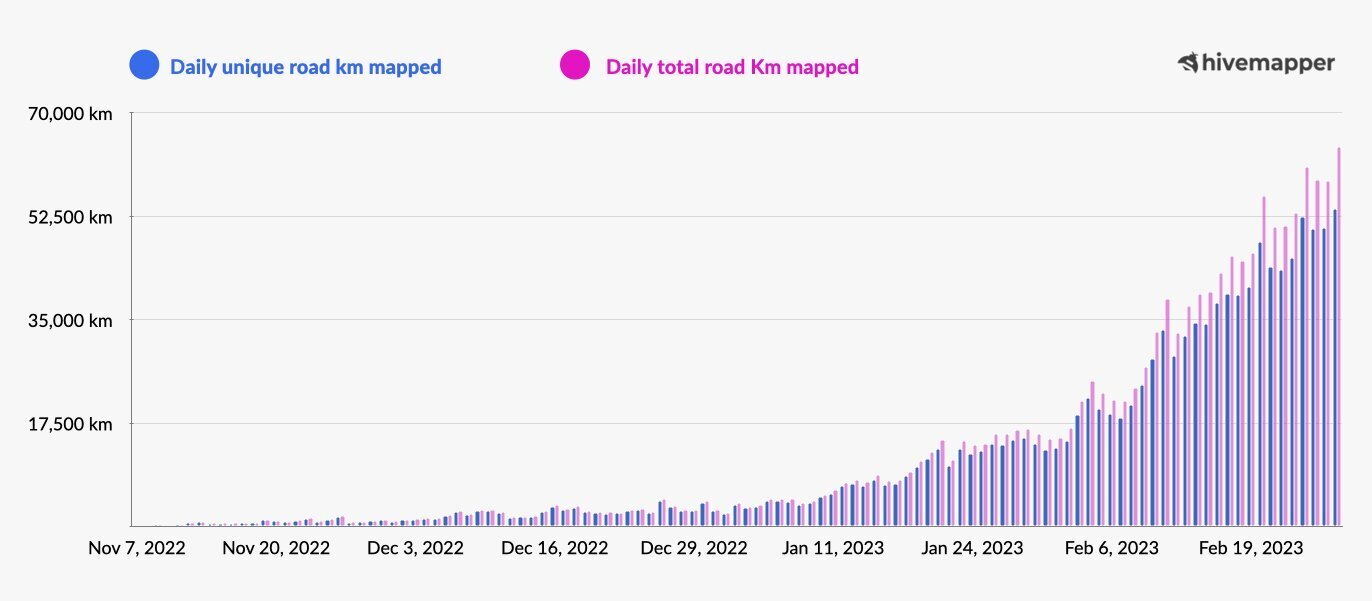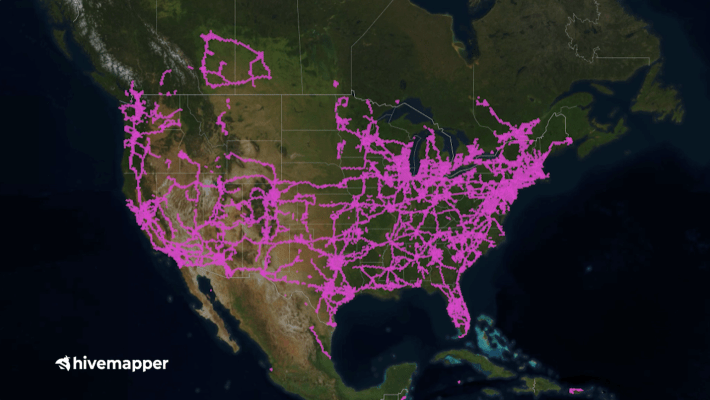Hivemapper, the startup that puts dashcams on ride-hail and delivery vehicles to map the world, is getting a little closer to its goal of toppling the B2B mapping empire that Google has built.
With only 2% of the world’s roads mapped, Hivemapper is still very much the underdog in this fight. But Gabe Nelson, Hivemapper’s head of operations, reckons the startup is reaching an inflection point that will lead to exponential scale.
Hivemapper said Thursday it collected more than 1 million kilometers (about 620,000 miles) of unique street-level imagery. Compared to Google’s 60 million kilometers, that’s small potatoes. However, Hivemapper collected this data over the last three months. It took Google from 2007 to 2019 to collect 16.1 million kilometers of unique road data.
Now the startup aims to map 10 million unique road kilometers by early next year.
Hivemapper relies on individual contributors around the world to collect its street-view data, rather than spending millions of dollars putting dedicated mapping vehicles on the road. Its dashcams are equipped with a high-quality imager and precise GPS, and they go for $549. Mapping with dashcams, the company says, means its data is continuously being refreshed, whereas much of Google’s Street View imagery, particularly outside of urban centers, is over a decade old.
It’s a similar model to GPS app Waze, which was acquired by Google in 2013. Waze relies on volunteer user data to monitor and share real-time traffic information around the world. Where Waze users actively contribute to improve the product or simply for the love of maps, Hivemapper contributors are promised something that has, at least in theory, the potential to be financially valuable.
Hivemapper rewards drivers and editors with its native token called HONEY. As more roads are mapped and the map becomes more useful to end customers, their demand for tokens increases. When companies purchase map data from Hivemapper, that money is converted into tokens in the back end, which the system can then use to reward new or existing contributors with more tokens. Ariel Seidman, Hivemapper’s CEO and co-founder, told TechCrunch there will only ever be 10 billion HONEY tokens in existence.
Before those tokens are actually worth anything at all, Hivemapper needs to collect enough data to be able to offer a viable product. The startup currently has more than 11,000 contributors and 418 regions mapped to some degree. For example, Hivemapper has tackled around 30% of Los Angeles’s roads, but only 1.4% of Genoa, Italy’s.
“Where this thing becomes really big is when you have 90% coverage in a region or in a country because then someone can completely replace what they’re using today with you,” said Nelson, noting the importance of fresh map data for businesses training autonomous vehicles. “On the map data side, we have conversations with a lot of the largest map data customers in the world. We’re in the validation stage with multiple of those.”

Hivemapper dashcam. Image Credits: Hivemapper
As part of its strategy to scale exponentially, Hivemapper is working to bring on fleets — particularly smaller to mid-sized fleets at first as the company builds up a network. Many fleets already buy dashcams as insurance in case their drivers get into accidents, so they’re more likely to follow best practices for mounting the devices and therefore will collect better quality imagery, Hivemapper reasons. Fleets also don’t always drive the same old routes, allowing Hivemapper to get data off the beaten track.
Fleet managers can access Hivemapper’s dashboard, which provides information on high-earning routes, where drivers are going and how many tokens they’re collecting. They can then redirect or split tokens to any designated wallet to reward drivers.
The startup is also incentivizing drivers to collect data in certain regions to help scale faster and provide fresher data in high-demand areas or in areas where there’s rapid adoption from contributors. Last week, Hivemapper said it would provide higher rewards in South Korea, the Netherlands, Portugal, London, Paris, Madrid and Tokyo, according to Nelson.
David vs. Goliath

Since launching in November 2022, Hivemapper has mapped over 1 million unique road kilometers. Image Credits: Hivemapper
“The map space is desperately in need of disruption,” Nelson told TechCrunch. “Google Maps is essentially a monopoly in B2B maps…They have about 5 million business and government customers. And because they have such dominance in this space, they have been exploiting their position. They’ve increased their prices 1800% since 2018. Customers are now ruthlessly limiting how much they use Google Maps APIs in order to save costs.”
Google did not confirm how many customers it has, nor whether the company has increased its prices by 1800%, a percentage that Hivemapper arrived at via internal estimation. Google said it hasn’t altered its price structure since 2018. Over the years, though, many businesses have complained about Maps APIs being unaffordable, leading to customers indeed pulling back on usage.
Those businesses are looking for cheaper alternatives. Companies like Mapbox have caught some absconders, but Hivemapper says it differs from the new competition because it collects and edits its own data, rather than relying on third parties. Mapbox, for example, uses OpenStreetMap (OSM) data, which is a free, open geographic database that’s also updated by a community of volunteers.
“I would argue that we do the full stack, and that’s really important because if somebody comes to Mapbox and asks for a better map of India, then they have to go to the OSM community and ask them to work harder. They don’t really have control over the data,” said Seidman.
At the end of the day, Hivemapper is betting on two things: The first is that the amount of money Google spends to collect street-view data will be its Achilles heel. And the second is that it will be able to build a large enough base of contributors who believe in the future value of HONEY tokens.
Seidman isn’t “religious about crypto.” He thinks of it as just a piece of technology, a tool that can give drivers shares of the company via tokens and incentivize them to improve the platform in a way that goes beyond whatever reason Waze’s over 30,000 volunteers do it for.
“In the early days of Waze, when all these people were contributing either by driving or editing the map and doing very tedious quality assurance work, they gamified the system,” said Seidman. “These people got these little candies for doing tasks. And when Waze ultimately monetized all that data by selling it to Google for $1.3 billion, they all had their virtual candies, but those weren’t worth anything. Hivemapper is different. Hivemapper also monetizes the data, but because the contributor did this work, they’re more economically aligned with people like me, quite frankly.”
